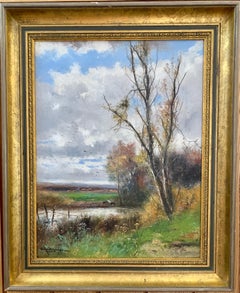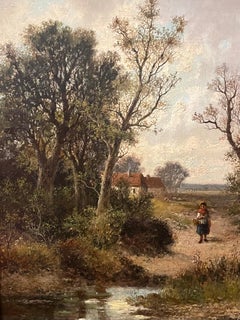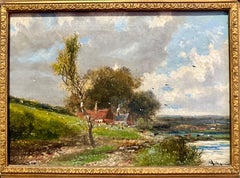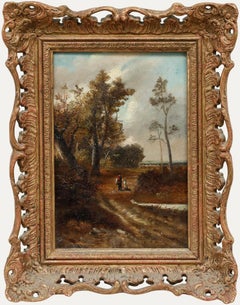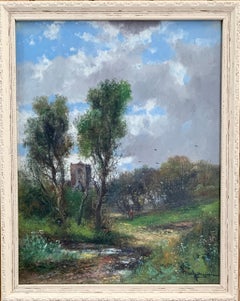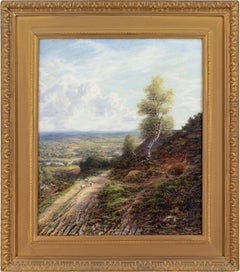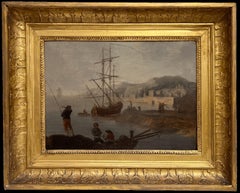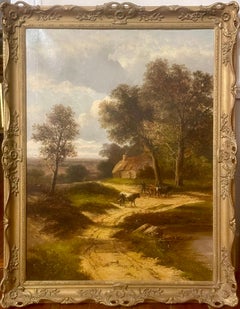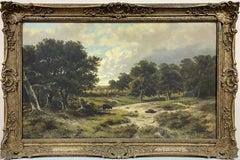Abraham Hulk the Younger Art
to
3
2
2
1
Overall Width
to
Overall Height
to
5
1
1
4
1
3
5
5
4
4
5
8,230
2,807
1,651
1,318
5
1
4
1
Artist: Abraham Hulk the Younger
Early 20th Century English Autumn river landscape, cows drinking from the stream
By Abraham Hulk the Younger
Located in Woodbury, CT
Early 20th Century English Autumn river landscape with cows drinking from a stream.
Abraham Hulk Junior was born in the Netherlands in 1851 to ren...
Category
1890s Victorian Abraham Hulk the Younger Art
Materials
Canvas, Oil
Landscape Near Felday, Surrey
By Abraham Hulk the Younger
Located in Hillsborough, NC
Dutch/English artist Abraham Hulk the Younger (1851-1922) is most known for landscapes of the British countryside. This work is one of a pair (the second work is also available by s...
Category
Late 19th Century Old Masters Abraham Hulk the Younger Art
Materials
Canvas, Oil
$2,240 Sale Price
20% Off
Cottages in Late Summer Landscape, impressionist late 19th/early 20th century
By Abraham Hulk the Younger
Located in Hillsborough, NC
Peaceful pastoral landscape by Abraham Hulk, the Younger (1844-1922), renowned for his landscape paintings with Dutch and English training. With his Dutch father as an artist, Hulk l...
Category
Late 19th Century Impressionist Abraham Hulk the Younger Art
Materials
Canvas, Oil
Abraham Hulk Jr. (1851-1922) - Late 19th Century Oil, An Autumnal Walk
By Abraham Hulk the Younger
Located in Corsham, GB
This atmospheric landscape painting captures a rural autumn scene, with tall trees framing a winding dirt path that leads the eye through the composition. The artist skilfully uses w...
Category
Late 19th Century Abraham Hulk the Younger Art
Materials
Oil
Early 20th Century English Autumn river landscape with a Norman Church
By Abraham Hulk the Younger
Located in Woodbury, CT
Early 20th Century English Autumn river landscape with a Norman Church.
Abraham Hulk Junior was born in the Netherlands in 1851 to renowned Dutch ...
Category
1890s Victorian Abraham Hulk the Younger Art
Materials
Canvas, Oil
Related Items
George William Mote, Near Guildford, Surrey
By George William Mote
Located in Cheltenham, GB
This late 19th-century oil painting by British painter George William Mote (1832-1909) depicts a shepherd and his flock before an extensive view across the Surrey countryside near Gu...
Category
1880s Victorian Abraham Hulk the Younger Art
Materials
Oil, Canvas
18th Century French Old Master Oil Painting Ancient Port Harbor Shipping Marine
Located in Cirencester, Gloucestershire
Harbor Scene
Circle of Claude Joseph Vernet (French, 1714-1789)
oil painting on canvas, framed in antique gilt frame
framed: 20.5 x 25.5
canvas: 19 x 23.5 inches
condition: very good...
Category
18th Century Old Masters Abraham Hulk the Younger Art
Materials
Oil, Canvas
$2,876 Sale Price
30% Off
H 20.5 in W 25.5 in
Antique English Grand Tour Old Master Oil Figures Classical Arcadian Landscape
Located in Cirencester, Gloucestershire
Classical Landscape
oil on canvas, framed
framed: 29 x 37 inches
canvas : 19 x 27 inches
Provenance: private collection, UK
Condition: the frame is exceptionally fragile and vulnerab...
Category
Early 19th Century Old Masters Abraham Hulk the Younger Art
Materials
Oil, Canvas
$2,389 Sale Price
30% Off
H 29 in W 37 in
Figures in Winter Dutch Snow Landscape Large 19th Century Oil on Canvas Painting
Located in Cirencester, Gloucestershire
The Winter Landscape
Dutch School, 19th century
oil painting on canvas, framed
framed: 22 x 28 inches
canvas: 16.5 x 23 inches
provenance: private collection, UK
condition: very goo...
Category
19th Century Old Masters Abraham Hulk the Younger Art
Materials
Oil, Canvas
$1,560 Sale Price
30% Off
H 22 in W 28 in
Large 18th Century British Old Master Oil Painting Figures at Dusk in Woodland
Located in Cirencester, Gloucestershire
The Close of Day
English artist, second half 18th century
circle of Thomas Gainsborough (British 1727-1788)
oil on canvas, unframed
canvas: 24.5 x 29 inches
provenance: private colle...
Category
18th Century Old Masters Abraham Hulk the Younger Art
Materials
Oil, Canvas
$2,145 Sale Price
30% Off
H 24.5 in W 29 in
Victorian landscape painting of Scottish fishing boats moored in a bay
Located in Harkstead, GB
A very tranquil scene of fishing boats moored in harbour with a sunlit sea beyond. Painted with a most attractive palette of blues and greens and with a pleasing composition that le...
Category
19th Century Victorian Abraham Hulk the Younger Art
Materials
Oil, Canvas
$2,089
H 16 in W 24 in D 2.5 in
Antique Roman painter - 18th century landscape painting - Wanderers - Italy
Located in Varmo, IT
Roman painter (18th century) - Landscape with wayfarers.
43.5 x 34.5 cm without frame, 58.5 x 49.5 cm with frame.
Antique oil painting on canvas, in a carved and gilded wooden fram...
Category
Early 18th Century Old Masters Abraham Hulk the Younger Art
Materials
Canvas, Oil
$1,200 Sale Price
44% Off
H 23.04 in W 19.49 in
Large Victorian Norwich School Oil Thatched Cottages in Rural Landscape, framed
Located in Cirencester, Gloucestershire
Artist/ School: Norwich School, circa 1876
Title: 'Norfolk Clay Lump and Thatched Cottages'.
Medium: oil on canvas, framed
Framed: 24 x 31 inches
Painting: 19 x 26 inches
Provenance: private collection, East Anglia...
Category
19th Century Victorian Abraham Hulk the Younger Art
Materials
Oil, Canvas
$1,657 Sale Price
30% Off
H 24 in W 31 in D 1 in
The Knight - painting - XVII century
Located in Roma, IT
The Knight is an original oil painting on canvas realized during the XVII century by an anonymous artist.
Provenance: Pecci-Blunt collection. Good condition...
Category
17th Century Old Masters Abraham Hulk the Younger Art
Materials
Canvas, Oil
Fall Landscape Impressionism Original oil Painting, Ready to Hang
Located in Granada Hills, CA
Artist: Vahram Meliqsetyan
Title: Fall
Medium: Oil on Canvas
Year: 2024
Style: Impressionism
Dimensions: 23.5" x 16.5" x 0.8" inch (60 x 42 x 2cm)
Presentation: Unframed, Gallery Wra...
Category
2010s Impressionist Abraham Hulk the Younger Art
Materials
Canvas, Linen, Oil
$2,200
H 23.5 in W 16.5 in D 0.8 in
Naval Battle Engagement at Sea Large Busy Battle Scene Many Ships, Signed Oil
Located in Cirencester, Gloucestershire
English School, early 20th century
signed
oil painting on canvas, unframed
canvas: 17 x 24 inches
provenance: private collection, Eng;and
condition: good and sound condition, minor ...
Category
Early 20th Century Old Masters Abraham Hulk the Younger Art
Materials
Oil, Canvas
$1,365 Sale Price
30% Off
H 17 in W 24 in
Shipping in Stormy Waters, Attributed to Italian Artist Francesco Guardi
By Francesco Guardi
Located in Stockholm, SE
The splendour of the tragic sea
Francesco Guardi and maritime painting in Venetian art
No Venetian painter was a stranger to the sea. After all, Venice was not only one of the most prominent ports of the Mediterranean, but indeed a city literally submerged in the ocean from time to time. Curiously however, the famous Venetian school of painting showed little interest in maritime motifs, favouring scenes from the iconic architecture of the city rather than seascapes. That is why this painting is a particularly interesting window into not only the painter Francesco Guardi himself – but to the significance of the element of water in art history, in absence as well as in the centre of attention.
Whether it be calm, sunny days with stunning views of the palaces alongside the canals of Venice or – more rarely – stormy shipwrecking tragedies at sea, water as a unifying element is integral to the works of painter Francesco Guardi (1712–1793). During his lifetime, Venetian art saw many of its greatest triumphs with names like Tiepolo or Canaletto gaining international recognition and firmly establishing Venice as one of the most vibrant artistic communities of Europe. While the city itself already in the 18th century was something of an early tourist spot where aristocrats and high society visited on their grand tour or travels, the artists too contributed to the fame and their work spread the image of Venice as the city of romance and leisure to an international audience, many of whom could never visit in person.
Still today, the iconic image of Venice with its whimsical array of palaces, churches and other historic buildings is much influenced by these artists, many of whom have stood the test of time like very well and remain some of the most beloved in all of art history. It was not primarily subtility, intellectual meanings or moral ideals that the Venetian art tried to capture; instead it was the sheer vibrancy of life and the fast-paced city with crumbling palaces and festive people that made this atmosphere so special. Of course, Venice could count painters in most genres among its residents, from portraiture to religious motifs, history painting and much else. Still, it is the Vedutas and views of the city that seems to have etched itself into our memory more than anything else, not least in the tradition of Canaletto who was perhaps the undisputed master of all Venetian painters.
Born into his profession, Francesco lived and breathed painting all his life. His father, the painter Domenico Guardi (1678–1716) died when Francesco was just a small child, yet both he and his brothers Niccolò and Gian Antonio continued in their fathers’ footsteps. The Guardi family belonged to the nobility and originated from the mountainous area of Trentino, not far from the Alps. The brothers worked together on more challenging commissions and supported each other in the manner typical of family workshops or networks of artists. Their sister Maria Cecilia married no other than the artist Giovanni Battista Tiepolo himself, linking the family to the most renowned Venetian name of the time. During almost a decade, Guardi worked in the studio of Michele Giovanni Marieschi, sometimes simply known as Michiel, a painted similar in both style and motif. Canaletto is, however, the artist Guardi is most often compared to since they shared a mutual fascination for depicting the architecture and cityscape of Venice.
During the course of his career, Guardi tried his hand in many different genres. He was as swift in painting landscapes, Vedutas of Venice, sacred motifs, interiors and architectural compositions as he was in a number of other motifs. His style is typical of the Venetian school but also distinct and personal once we look a little closer. There is an absolute certainty in the composition, the choice of which sometimes feels like that of a carefully calculated photograph – yet it is also very painterly, in the best sense of the word: fluid, bold, sensitive and full of character. The brushwork is rapid, intense, seemingly careless and extraordinarily minute at the same time; fresh and planned in a very enjoyable mixture. His interiors often capture the breath-taking spacious glamour of the palaces and all their exquisite decor. He usually constructed the motif through remarkably simple, almost spontaneous yet intuitively precise strokes and shapes. The result was a festive, high-spirited atmospheric quality, far away from the sterile and exact likeness that other painters fell victim to when trying to copy Canaletto.
The painting here has nothing of the city of Venice in it. On the contrary, we seem to be transported far away into the solitary ocean, with no architecture, nothing to hold on to – only the roaring sea and the dangerous cliffs upon which the ships are just moments away from being crushed upon. It is a maritime composition evoking both Flemish and Italian precursors, in the proud tradition of maritime painting that for centuries formed a crucial part of our visual culture.
This genre of painting is today curiously overlooked, compared to how esteemed and meaningful it was when our relationship to the sea was far more natural than it is today. When both people and goods travelled by water, and many nations and cities – Venice among them – depended entirely on sea fare, the existential connection to the ocean was much more natural and integrated into the imagination. The schools and traditions of maritime art are as manifold as there are countries connected to the sea, and all reflect the need to process the dangers and wonders of the ocean.
It could symbolize opportunity, the exciting prospects of a new countries and adventures, prospering trade, beautiful scenery as well as war and tragedy, loss of life, danger and doom. To say that water is ambivalent in nature is an understatement, and these many layers were something that artists explored in the most wondrous ways. Perhaps it takes a bit more time for the modern eye to identify the different nuances and qualities of historic maritime paintings, they may on first impression seem hard to differentiate from each other. But when allowing these motifs to unfold and tell stories of the sea in both fiction and reality – or somewhere in between – we are awarded with an understanding of how the oceans truly built our world.
In Guardi’s interpretation, we see an almost theatrically arranged shipwrecking scene. No less than five ships are depicted right in the moment of utter disaster. Caught in a violent storm, the waves have driven them to a shore of sharp cliffs and if not swallowed by the waves, crushing against the cliffs seems to be the only outcome. The large wooden ships are impressively decorated with elaborate sculpture, and in fact relics already during Guardi’s lifetime. They are in fact typical of Dutch and Flemish 17th century ships, giving us a clue to where he got the inspiration from. Guardi must have seen examples of Flemish maritime art, that made him curious about these particular motifs. One is reminded of Flemish painters like Willem van de Velde and Ludolf Backhuysen, and this very painting has indeed been mistakenly attributed to Matthieu van Plattenberg...
Category
18th Century Old Masters Abraham Hulk the Younger Art
Materials
Canvas, Oil
$47,936 Sale Price
32% Off
H 25.79 in W 29.14 in
Previously Available Items
Countryside Home
By Abraham Hulk the Younger
Located in Hillsborough, NC
Large scene of the English countryside, late 19th century/early 20th century by Abraham Hulk the Younger (1851-1922, son of Dutch maritime artist Abraha...
Category
Late 19th Century Naturalistic Abraham Hulk the Younger Art
Materials
Canvas, Oil
Fine Victorian Large Oil Painting Animals in Pastoral Landscape, Beautiful Frame
By Abraham Hulk the Younger
Located in Cirencester, Gloucestershire
Artist: Abraham Hulk, Jnr. (British 1851-1922), signed lower right corner
Abraham Hulk Junior (or Abraham Hulk the Younger) was known for his aptit...
Category
19th Century Victorian Abraham Hulk the Younger Art
Materials
Canvas, Oil
Pair of 19th century landscape oil paintings of the Thames
By Abraham Hulk the Younger
Located in Nr Broadway, Worcestershire
Abraham Hulk Jnr
British/Dutch, (1851-1922)
The Thames at Westminster & Companion
Oil on canvas, pair, both signed
Image size: 5.75 inches x 7.75 inches
Size including frame: 9.75 in...
Category
19th Century Victorian Abraham Hulk the Younger Art
Materials
Canvas, Oil
19th Century British Maritime Oil Painting Shipping in Rough Seas - Old Port
By Abraham Hulk the Younger
Located in Cirencester, Gloucestershire
Fine quality late 19th century British marine oil painting by the well listed Dutch born artist, Abraham Hulk Jnr. (1851-1922). The painting is signed to the lower left corner.
Dep...
Category
Late 19th Century Realist Abraham Hulk the Younger Art
Materials
Oil
Abraham Hulk The Younger art for sale on 1stDibs.
Find a wide variety of authentic Abraham Hulk the Younger art available for sale on 1stDibs. You can also browse by medium to find art by Abraham Hulk the Younger in canvas, fabric, oil paint and more. Much of the original work by this artist or collective was created during the 19th century and is mostly associated with the Old Masters style. Not every interior allows for large Abraham Hulk the Younger art, so small editions measuring 16 inches across are available. Customers who are interested in this artist might also find the work of Frank Hider, Andrew Grant Kurtis, and Philip Rideout. Abraham Hulk the Younger art prices can differ depending upon medium, time period and other attributes. On 1stDibs, the price for these items starts at $1,560 and tops out at $2,800, while the average work can sell for $1,560.
